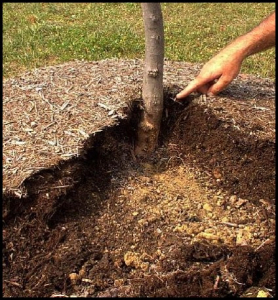One of the great things about gardening is everyone can incorporate their own styles by selecting plants and features they enjoy. However, there are some common mistakes in the landscape everyone should avoid so that they can avoid future problems and keep their plants healthy.
Here would be my “Top 5” common landscape mistakes (in no particular order):
- Volcano mulching – Mulch provides many benefits such as reducing weeds and conserving soil moisture. A common mistake that occurs is when mulch is piled up around tree trunks, as known as volcano mulching. This pile of mulch can cause damage to the tree trunk by holding moisture which can create insect and disease problems along with bark decay. A good layer of mulch should be 2 to 4 inches deep. The mulch should be pulled 1 to 2 inches away from the base so that you can see the base of the tree trunk.
- Right Plant, Right Place – Instead of haphazardly placing plants anywhere in a landscape, it will pay off to first do some research on plants you are interested in. Not all plants grow successfully in our climate. You will be more successful and happier with your landscape when you select plants suited for your landscape conditions. Selected plants should be recommended for our area’s hardiness zone which is an 8a. Next, before investing in any plants, it is important to become familiar with your property. Make note of what areas receive full sun verses partial shade or full shade. Pay attention to soil drainage. Note the spots where the water sits for long periods of time after a good rain compared to areas that stay very dry. Once you know these areas, look at plants labels or look them up in books/on internet to see which are full sun verses shade and which can handle dry soils verses wet soils.
- Give Plants their Space – Those plants you purchase for your landscape will not stay that size forever! Often new landscapes are filled with “small” shrubs and trees only to discover several years later they are over grown and covering windows, blocking sidewalks and encroaching on power lines. Check the plant label before purchasing to determine how big the plant will become and purchase the right size plant for the location where it will be placed. Look for dwarf varieties or small-sized plants to place closer to your home, windows, doors, sidewalks and under power lines.
- Don’t Plant too Deep – Often one can find shrubs and trees planted way too deep. When planted to deep, it not only causes the roots to suffocate but also rots the base of the trunk. Roots will grow where there is optimum oxygen in the soil, which would be closer to the soil surface. The base of a tree or shrub should be exposed to air and not covered by soil. Planting too deep results in the bark and wood rotting thus preventing the plant from moving water and nutrients from the roots to the plant’s top portion resulting in a slow death. When digging a planting hole, it should be two to three times the width of the plant’s rootball and the depth slightly higher than the height of the root ball.
- Crape Murder – Improper pruning of crape myrtles is a common occurrence. Often you will see crape myrtles with the tops cut off so that there are just a few large branches or stubs left (aka crape murder). This type of pruning in not recommended because it destroys the natural form and shape of the plant. Usually crape myrtles only need light pruning by thinning out areas with many branches by cutting selected limbs back to where it meets another branch. This will avoid leaving stubs that will produce weak branches which will sag or break from the weight of the flowers. Remember that the best time to prune crape myrtles is in late February just before new spring growth begins.
Jessica Strickland is an Agriculture Extension Agent, specializing in horticulture for North Carolina Cooperative Extension in Wayne County.

(Photo Credit: NC State Extension)

